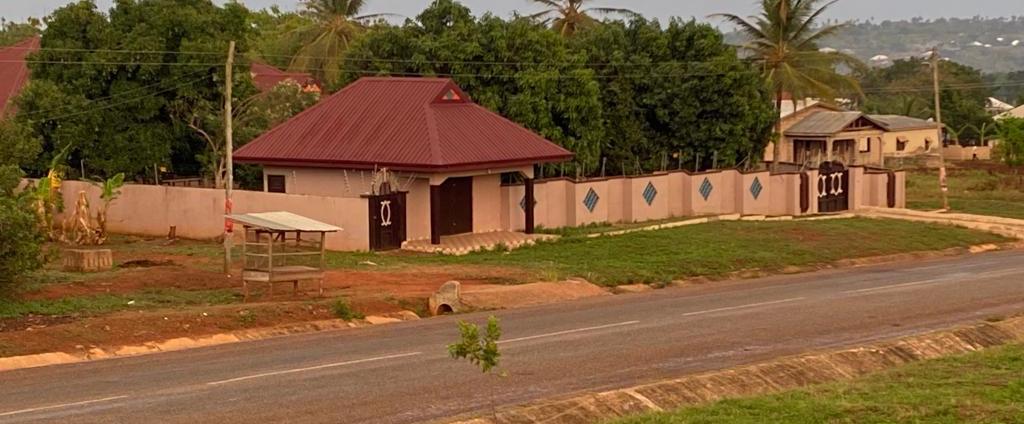Traditions claim that the royal Aduana lineage of Sekyedumasi, in the Ejura-Sekyedumasi Municipal of Asante, originated from Asumegya-Asantemanso.
While they were living on this ancestral homeland, dispute occurred within the entire Aduana family. As a result, a section of the royal Aduana family emigrated northwards under the leadership of Nana Miri Boafo and his sister called Tiwaa-Gyaakroma, accompanied by seven hundred warriors.
They first went to Asekye near Amowi in present day Nkoranza Traditional Area. While at Asekye, the Takyimanhene married Tiwaa-Gyaakroma and had three issues with her – a boy called Aka Sraman, and two girls – Danowa and Afrahemaa, Danowa married at Wenchi where her descendants are still living.
Later, Nana Miri Boafo and his followers continued the journey to Takyiman-Kenten where they settled and the leader was made an Osafohene by Nkoranzahene who placed the villages of Wurakasi and Krobo under him.
The migrant-leader died and was succeeded by his nephew Aka Sraman. During his reign, King Opoku Ware of Kumase, invaded Takyiman 1722/23. Aka Sraman joined the Takyimanhene to fight the Asante army because at that time all the land of Nkoranza belonged to the Takyimanhene Ameyaw.
When the war ended in favor of the Asantehene, Aka Sraman’s contingent surrendered to the Asante army and traveled with them to the Asante army and travelled with them to Donkoro-Nkwanta where Aka Sraman summoned his elders and revealed to them his intentions to discontinue the journey to Kumase for the victory celebration. Since he had no male relative within the royal Aduana family, except his only sister Afrahemaa, he charged his son Gyima of Oyoko by birth, to lead the desperate-looking people.
He surrendered to Gyima his war-medicine, two brass belts, an iron helmet, one live faggot, a sealed box and one white stool. Again he attached two fetish priests called Tertia and Taa Kwaku to the Stool property. Lastly, he instructed that
“if and when my sister gives birth to a male child then Gyima should surrender stool properties to his nephew in conformity with matrilineal system of Stool succession. And may you grow to prosper and establish a new stat for my people”
After the handing-over ceremony, Nan Aka Sraman vanished into thin air and was never again seen, because he was not prepared to appear before the Asantehene whom he had fought against.
The following chiefs and Stools accompanied Nana Gyima to Kumase. Okyeame Apau, Kwame Kantaku’s Stool(Wurakesehene), the Odikro of Droben, Ba Saprong’s Stool which is now known as Dapaafohene.
On the arrival at Kumase, Nana Gyima swore the Oath of Allegiance to the Asantehene, and vowed never to return to Takyiman, they were directed by the Asantehene to settle at Anyinasuso under the protection of the Ahenkrohene Nana Ntim Bafour fo the Oyoko Clan. Later, the war prisoners indulged themselves in excessive drinking as they bemoaned their plight while in captivity; they credited drinks at Offinso. As the host became liable for the debt, he reported the extravagant behaviour to the Asantehene who placed them under the Ankaakihene Nana Yamoa Ponko. But when the Ankaasihene died, a great number of the war prisoners were sacrificed. Truly, the Asantehene deplored the conduct of the Ankaasi people and consequently placed them under the Nsumankwaahene of Kumase, Nana Domfe Napare who was very kind to them.
They found Anyinasuso settlement unsuitable so they first went to Ejura where they were welcomed by Ejurahen Krubu Kumah. They moved inland via Aframso road and settled permanently at their present home which was more suitable for them as it was on the border between the forest and the Savannah. According to the Sekyedumasihene, Nana Kofi Anti II, Aka Sraman and Afrahemaa and their adherents arrived at Sekyedumasi about 1750, and that the Aduana royals’ swored that they would serve and swear only to the Asantehene, and the descendants of the Sekyedumasi royal lineage have since invariably kept his Oath. Nana Kofi Nti was enstooled 1/12/1944; destooled 16/9/1946, and re-instated 4th December, 1958.
When they arrived at their new home, they found the area covered with Odum-trees, and because they settled first at Asekye before migrating from there, they named it Asekye-Odum-ase, which has since then been corrupted into SEKYEDUMASI. Aka Sraman’s son, Gyimah who brought the stool to Sekyedumasi died there. He was succeeded by a son of the Queen-mother(Afrahemaa) called Owusu Ansah.
This article uses material from the Ghana National Commission on Culture, writen by: KWAME AMPENE (Founder of the Guan Historical Society)

